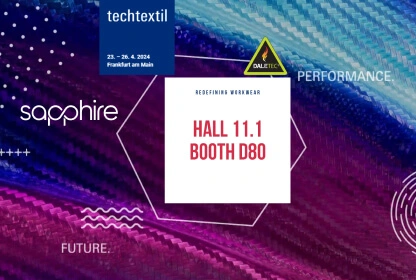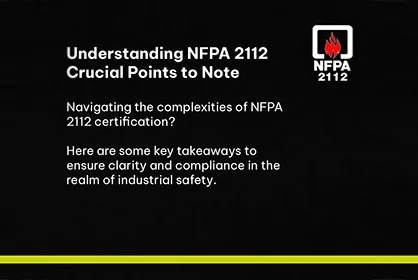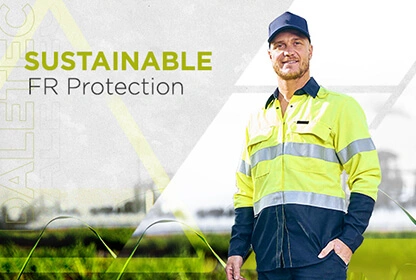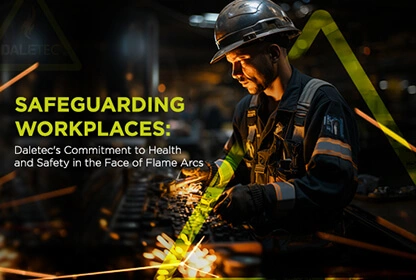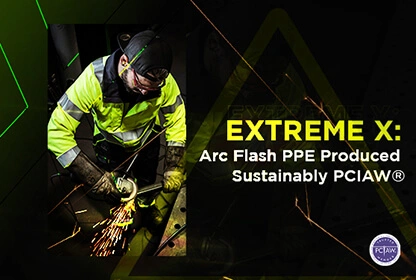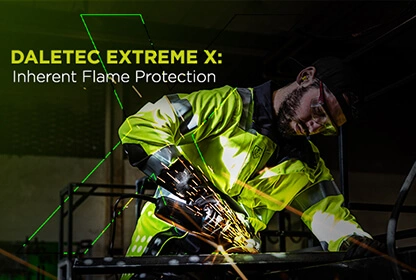October 5, 2020
News & Media
What is ELIM?

Being a pioneer in field of Fire retardant fabrics, Daletec understands that there can be no compromise on human safety. Protective fabrics manufactured and supplied by Daletec not only qualifies to all relevant norms (ISO 11611, ISO 11612, IEC 61482 and NFPA 2112) but also surpass the bare minimum performance levels mentioned in these norms.
Protective clothing saves workers’ lives from injuries and incidents at work place. As responsible FR fabric suppliers, it is our priority to ensure that the FR fabrics provide protection to workers from flame, fire and sparks and should be durable and comfortable. There are several other parameters which should be considered by PPE managers while evaluating the risk at workplace and defining the protection levels for workers.
We have discussed few of these safety parameters in this paper and have highlighted the significance for better understanding.
What is ELIM?
ELIM: Energy Limit Value
Numerical value of incident energy attributed to a product, below which there is no data point with the amount of heat transmitted through the product reaching the Stall criteria or with the product exhibiting breakopen.
Note 1 to entry: The ELIM of a material or material assembly (garment) is calculated from data points obtained from testing a set of test specimens, which are also used for the determination of the ATPV and/or EBT.
Note 2 to entry: The ELIM attributed to a garment or garment assembly is either equal to or lower than the ELIM of the material or material assembly of which it is made, depending on whether the tested specimen(s) fulfil also additional visual design and performance assessment criteria
ELIM
(Average of the three highest values of the incident energy data points of the date
Set below the mix zone without breakopen and without reaching Stoll curve)
This is a more conservative calculation of risk, all results for calculating ELIM is taken below the 50% chance of a 2 degree burn according to the Stoll curve.
Easy and compressed explanation:
ELIM is the conservative calculation of risk of an electric arc.
ELIM the maximum incident energy that a protective clothing can prevent against in a hazardous situation, with 0% probability of enough energy getting through the garment to cause a second-degree burn.
ELIM has been introduced because the opinion of EU was that 61842-1-1 could be in conflict with EU directive. According to directive, no standard can impose harm to a worker. By this, ATPV/EBT imposes 50% probability that a worker will sustain second degree burn in electric arc exposure. This means that the worker will statistically have burns every other time.
It is this 50% chance that ELIM has eliminated. However, it is just exactly in this way of testing as defined in the IEC 61482-1-1 open arc testing.
How if it will affect the marked and the practical use in a risk assessment plan for electrical work in the EU is not 100% clear, but there is ongoing discussion about taking NFPA 70E arc flash risk assessment into the EN 50110 Operation of electrical installations standard.
What is an electric arc?
An electric arc, or arc discharge, is an electrical breakdown of a gas that produces an ongoing electrical discharge. The current travel through a normally nonconductive medium such as air and produces a plasma; the plasma may produce visible light.
It can look like a spark or a huge lightning depending on the intensity (power) of the electrical discharge. An electrical arc can generate and radiate a lot of energy/heat that can injure people within a certain distance from the arc (depending on the energy of the arc).
What is risk assessment?
Risk Assessment can be described as a systematic process of evaluating the potential risks that the employees may be exposed to in a hazardous work environment.
Risk Assessment is a requirement to ensure the safety of the employees.
Risk assessment involves three major areas for analysis:
-
Hazard Identification – Determine which hazards and risks in a work environment that could potentially cause injuries or damage to workers
-
Risk Evaluation – analyze the extent of risk associated with the workplace hazards
-
Risk Control – Determine proper measures that would lead to elimination of the hazard or at least minimize the risk if the hazard cannot be eliminated
Risk assessment are regulated in ISO 27001 (under the overall standard ISO 31000 on the implementation of risk management), and in NFPA 70E, where ISO is a global standard and NFPA 70E is a norm regulated in the USA but which is commonly referred to in many other countries.
How can I find out about a fabric’s arc rating?
If a FR fabric is to be used in a garment that is to be labeled with arc rating symbol, the fabric itself has to be certified according to either IEC 61482-1-1 or ASTM F1959, meaning that all certified fabrics will have a test report showing the arc rating value.
Depending upon your risk assessment you will be able to determine the level of protection that is applicable in your work situation. As the producers of arc rated garments in certain countries are required to list the minimum arc rating on their labels, you can easily pick and choose what sort of fabric will be suitable for your workspace requirements. For your convenience, below is the table with minimum arc rating listed for each hazard risk category.
|
Hazard Risk Category |
Minimum Arc Rating |
Proper Apparel Needed |
|
HRC 1 |
4 cal/cm2 |
Arc-rated shirt and pants or arc-rated/flame-resistant coveralls |
|
HRC 2 |
8 cal/cm2 |
Arc-rated shirt and pants or arc-rated/flame-resistant coveralls |
|
HRC 3 |
25 cal/cm2 |
Arc-rated shirt and pants or arc-rated/flame-resistant coveralls and arc flash suit |
|
HRC 4 |
40 cal/cm2 |
Arc-rated shirt and pants or arc-rated/flame-resistant coveralls and arc flash suit |
The level of arc protection required by an organization is determined based on their own risk assessment of the items, situations, and processes involved in a workplace that pose a risk to the employees. According to NFPA 70E, almost 90% of all the electrical trade workers require Category 1 and 2 protection, which means that their FR clothing should have an ATPV rating of 8 or higher. Category 1 has minimum Arc Rating of 4 whilst Category 2 has minimum Arc Rating of 8.
What is ATPV related to PPE?
ATPV is short for Arc Thermal Performance Value, which refers to the maximum incident energy that a protective clothing can prevent against in a hazardous situation, with 50% probability of enough energy getting through the garment to cause a second-degree burn, according to test standards ASTM F1959 and IEC 61482-1-1.
The Arc Thermal Performance Value is measured as calories/cm², which is seen as the amount of energy which the fabric is protecting against where it is still not resulting in a 50% chance of a second-degree burn. The necessary Arc Rating which is needed in a certain work situation is determined by a Hazard/Risk Assessment which clarifies which HRC level is needed.
What is EBT?
EBT is the Energy Break-open Threshold of a fabric. EBT indicates the incident energy measured during testing, at which point the fabric is not able to withstand the energy and results in a 50% probability of breaking open. A hole/opening of an area of 1.6cm² (0.5 in.²) is referred to as break-open. When there is a hole in the fabric there is no barrier protecting the skin, therefore the EBT value will be the limitation of protection. EBT is measured as calories/cm².
What is better, ATPV or EBT
Both ATPV and EBT are Arc Ratings. Both ratings exhibit a 50% probability of reaching performance threshold but using different parameters for considering the performance.
Both Arc Ratings are practical equivalents and as such, both are equally applicable in hazard assessment. A material either receives an EBT or an ATPV as its Arc Rating according to ASTM F1959 and as specified by NFPA 70E and IEC 61482-1-1; only the lower of the two parameters is used as the Arc Rating on the garment label.
What is STOLL CURVE?
This does not mean that the wearer has a 50% chance of receiving a second-degree burn.
The Stoll Curve is used to determine for pass/fail criteria for personal protective equipment and is a threshold for predicting burns.
The graph of the Stoll Curve represents the reaction of human tissue, a technical way of measuring if a second-degree burn happens, instead of using actual people and their skin in the testing, which would be horribly cruel.
In arc flash testing, copper calorimeters behind the exposed fabric panel report the energy which passed through the material, and other uncovered calorimeters record the energy incident on the fabric.
The Stoll Curve is to determine the time and energy and if a fabric/garment will prevent the influx of pain and second-degree burn.
NFPA 70E, considers a ‘survivable burn’ as only a 50% probability of second-degree burn. This means the heat flux only has a 50% probability of crossing the Stoll Curve
More to this for understanding; as an extra info for the possibility of injury
Comparison of possible injury NFPA 2112 and NFPA 70E:
The actual fabric/garment area the arc hits is very small and would likely amount to less than 25% of the body receiving the onset of second-degree burns.
The arc flash standard is very conservative compared to flash fire standards like NFPA 2112.
The NFPA 2112 allows 50% of the entire body to get second and third degree burns in a flash fire exposure.


